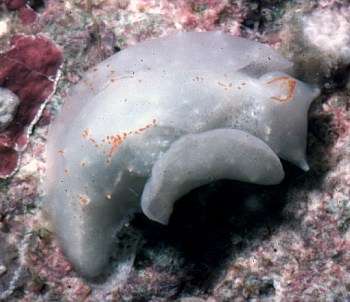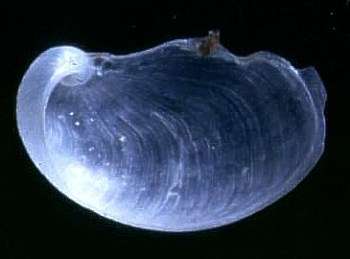Sagaminopteron nigropunctatum
August 7, 1999
From: C.J. Carlson & P.J. Hoff


Bill,
Since you had a spate of Gastropteridae lately, we thought we would add one, Sagaminopteron nigropunctatum Carlson & Hoff, 1973, that most people haven't run into. We presently have records for this animal from Guam, Rota (Northern Marianas), Palau and Cabilao in the Philippines. It is probably fairly wide spread in at least the Western Pacific but can be difficult to see on its host sponge (I know you don't believe this) Dysidea granulosa Bergquist, 1965. Two specimens found in the Philippines were on Dysidea herbacea and were very pale.
UPPER PHOTO: 13.0mm; Philippines, Cabilao Is., 5m; 28 April 1997 found on Dysidea herbacea. LOWER PHOTO: S. nigropunctatum shell, from 12.5mm specimen; ventral view, approximate length 3.5mm
[See other photos Clay & Patty Jo sent at Top of Page.]
Clay & Patty Jo
Merizo, Guam.
clay.carlson@kuentos.guam.net
Carlson, C.J. & Hoff, P.J., 1999 (Aug 7) Sagaminopteron nigropunctatum. [Message in] Sea Slug Forum. Australian Museum, Sydney. Available from http://www.seaslugforum.net/find/1150Dear Clay & Patty Jo,
Thanks for the photos, including the shell and egg mass photos. With cryptic animals egg masses are often the first sign that something is there. I hope the more species we can illustrate on the Forum, the more eyes will be alerted to go and have a look.
Concerning the sponge story. I don't dispute that many species of gastropterid are found associated with particular sponges, much like many species of the nudibranch dorid Trapania are found associated with sponges. What I think we should be alert to is the possibility that the close association is not necessarily an indication that the sponge is their food. In both Sagaminopteron and Trapania their relatives are not sponge feeders and in both Sagaminopteron and Trapania their radular morphology is very similar to that of their relatives, suggesting that if they are eating the sponges, then they have evolved no radular modifications to do so.
Of course this is possible, but I think we should keep looking. It is of course not made any easier by the fact that species of Dysidea don't have a spicule based skeleton, so stomach contents are not going to be of great help.
Best wishes,
Bill Rudman.
Related messages
-
Sagaminopteron nigropunctatum from Reunion Island
From: Philibert Bidgrain, May 4, 2010
